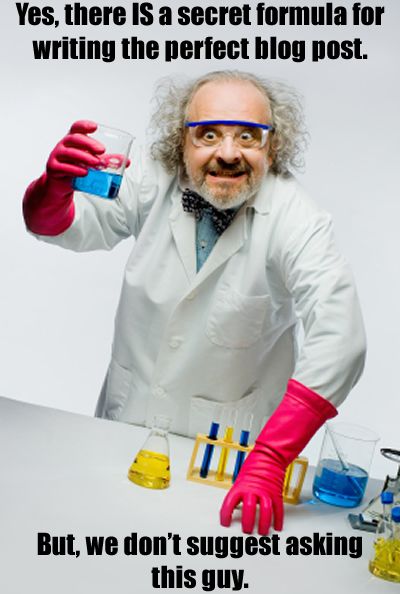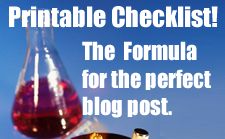How to Write the Perfect Blog Post
Nothing is perfect, you say? Well, maybe not, but your blog posts can be awfully close! Before you write anything, make sure you have a good topic. We’ve written extensively on how to find great blog topics. Ready to write? Let’s go!

Do Your Research
- Not with a view to using other people’s content, but to gather facts and ideas. You’ll cite those in your article or as “related articles” at the end of your post, so keep track of them.
- Make sure that any statistics you use are recent.
- Check your keyword list and choose one or two you’ll feature (Don’t have a keyword list? We can help.)
Create a Powerful Blog Post Title
- Use your keywords, but naturally.
- Will it draw in the casual browser?
- Don’t be afraid to be a bit provocative.
- Avoid using a confusing or irrelevant title. You may attract attention, but not of the right variety!
- “How to…” and “Ten Ways to…” “Why You Must… Now!” tend to work well.
- If your article starts to veer away from the title you have chosen, either get back to the topic, or change the title. This one seems obvious, but it is easy to overlook. Trust me.
Permalink or URL
- Use applicable keywords.
- Remove unnecessary words such as ‘and’ and ‘or’.
Content
- Make your first sentence a good one. Use keywords. Make it compelling, so readers continue. This is another good thing to go back and check when you’re finished. Is it still a good introduction to your post?
- Explain yourself. If you are using terms that might not be well-understood by any potential reader, define it, if it can be done briefly, or link to more information. You want to educate, not overwhelm.
- Use short paragraphs and simple words.
- Use headers – with keywords! This is not as much for SEO (search engine optimization) as for letting people who found your article by using those keywords know that they will find what they are looking for as they first skim your article.
- Link to other articles on the site. If your post mentions Pinterest, and you have written a great blog post about Pinterest, link to it!
- Link to the articles you used in your research or would otherwise be helpful to your readers.
- Use bulleted lists for ease of reading.
- Use keywords naturally throughout.
- Use key phrases verbatim. Example, if you are going to write about how to deal with a certain error message, mention it word-for-word. People will search for this. For example, if you are writing an article on how to deal with this Facebook error, “to ensure your account security, please complete this process on a computer you’ve used in the past. if this isn’t possible, please contact customer support from the help center”, use the entire phrase in your post.
Images
- Use at least one appealing image per article.
- Never use an image you copied from another site. Stick to your own works or royalty-free stock photos.
- Always fill out the name or title and the “alt text” field. Use keywords, but be authentically descriptive.
- Should the image link to another page, either on or off your site?
Think Social Blogging

Click to get the printable version – perfect for posting on your wall!
- When writing your title, think about Twitter. Would it work as an update (keep it under 120 characters to allow for RT, if possible).
- When adding images, think Pinterest. Is there a large, appealing image? Could you add a caption to the image that would make people want to click through to read your post (many people don’t read the pinterest-supplied description).
Category,Tags, Title and Description – Blog Housekeeping
Choose the appropriate category for your blog post. Feel free to choose more than one, if appropriate. WordPress suggests tags based on your content, so choose the ones that apply, but think outside those options to other key words and phrases that may apply.
If you are using an SEO plugin, make sure the title is displayed the way you would like it to appear in a list of search engine results. The description (or “Meta Description”) is often displayed below the title in search engine results, so it is often best not to let it default to the first part of your article. Instead, briefly describe what will be covered, keeping in mind that you’ll want to draw in the reader, so feature what is in it for them. Because it is shown under the title, there is no need to restate what is in the title. Use the description to add to it, instead.
Edit Your Blog Post
- Read it out loud. Does it sound like you and the way you actually speak? You’re not writing a text book – be real.
- Can you shorten anything? Shorter is better.
- Check for spelling (in WordPress and many other platforms, look for red squiggles)
- Check for proper grammar.
- Is the title you chose at the beginning still the best title? Change it if you need to.
Bonus: Tips from other bloggers
I asked on our Facebook Page, “What’s ONE thing you always do when writing a blog post?”. Here are the responses I got:
- “I’ll start – I always include an image that will work really well on Pinterest. That is, it’s large, interesting and usually captioned with the subject of the post”. ~ Alisa (that’s me!)
-
“I always make sure I have good links!” ~ Kerry Armour of Millipede Media Group
- “Thesaurus! It’s always fun to see if you can one-up yourself by finding a jazzier word!” ~ Kristi Miller
- “Proofreading is extremely important to me; it’s the 7 years as a secretary I think. But for me personally what I like to see and what I strive to do in my posts is to put LIFE into them. I post sometimes on a purely informational basis, and there’s a place for that, I suppose, but I do love to tell a story and pull my reader in, if it is at all possible.” ~ Gretchen Halverson of Scalable Social Media
- “I guess the last thing I do is change my blog title. I know it sounds weird – to work backwards, but my titles tend to morph as I write and I end up needing to change them after I see how the article actually developed.” ~ Tina Gammon of Scalable Social Media
End With a Question
You know you don’t have all the answers. Your readers might have some really great suggestions. So, go ahead and ask! Oh, and is goes without saying that you should always respond to thoughtful comments.
Tell the World About Your Perfect Blog Post
Share it on all your social media platforms and in email. This will be the subject of a future post.
What blogging tips would you like to add? Please comment below – and thanks!
Continue reading here: Fan Page Friday - What is it and How you can Benefit
Was this article helpful?
Readers' Questions
-
duenna1 year ago
- Reply


